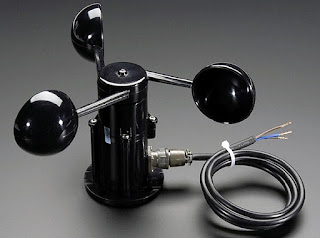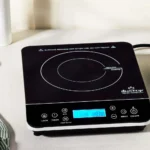
An anemometer is a weather instrument used to measure the speed of the wind. It is frequently found in weather stations. The term anemometer is derived from the Greek word anemos, which means “wind.” An anemometer is any tool used to measure the speed of wind in the science of meteorology. Leon Battista Alberti invented the first mechanical anemometer around 1450. It hasn’t changed much since then, despite the fact that some later anemometer inventions were mistakenly credited as the first. The cup anemometer, invented by Dr. John Thomas Romney Robinson in 1845, is one of the most basic anemometers. There are many different types of anemometers available today.
Anemometers can be used to measure wind speed in an open environment, such as the open air. They can also be used to measure the wind speed of an enclosed environment’s airflow.
Vane anemometers, cup anemometers, thermal anemometers, and thermal anemometers with velocity temperature profiling capability are the most common types of anemometers.
Anemometers are useful for a variety of purposes, including weather reporting and forecasting, studying air movement, weather patterns, flight, and engineering.
Laser anemometers are used to assist in determining the flow of air speed around vehicles, airplanes, and spacecraft. Because these measurements are used in design, they can help improve the aerodynamic design of these vehicles.
Vane anemometers resemble a propeller or windmill, and their axis is horizontal, as opposed to the cup anemometer’s vertical axis.
A hot wire anemometer employs a hot wire to measure wind speed as air flow passes through and cools the wire.
A laser Doppler anemometer employs a laser that is divided into two beams and calculates the speed of introduced particles in the air, allowing the speed of air around the anemometer to be determined.
An ultrasonic anemometer measures wind velocity using ultrasonic sound waves to determine wind speed.
A sonic anemometer has been replaced by an acoustic resonance anemometer. Dr. Savvas Kapartis invented it in 2000. To determine air speed, this anemometer uses resonating acoustic waves.
A ping-pong anemometer works by attaching a ping-pong ball to a string that blows in the wind. The angle formed by the vertical and the ball is measured, and this yields an estimate of the wind speed.
A plate anemometer is made up of a flat plate that is deflected by wind from the location where it is suspended.
The pressure of wind blown into a tube is measured by a tube anemometer to determine wind speed.
Anemometers are critical at airports where wind data is critical for safety. This wind data allows flight crews to predict when freezing rain and icing are likely to occur.
Heated anemometers are essential for use in cold weather conditions. Heating options are available for both sonic anemometers and cup anemometers.
The height at which an anemometer is placed is important for the accuracy of wind speed measurement, as well as its location in relation to obstructions such as trees, buildings, and canyons.
Anemometer FAQs: Everything You Need to Know About Wind Speed Measurement
Anemometers are fascinating instruments that play a crucial role in weather observation and various other fields. Here are some of the most common questions people search about anemometers, answered comprehensively:
1. What is an anemometer?
An anemometer is a device used to measure wind speed and, in some cases, wind direction. It typically consists of rotating cups, propellers, or other moving parts that are spun by the wind. The speed of rotation is then translated into a wind speed reading.
2. How do different types of anemometers work?
There are several main types of anemometers, each with its own operating principle:
- Cup anemometer: The most common type. It has three or four cups mounted on horizontal arms, which rotate proportionally to the wind speed.
- Propeller anemometer: Similar to the cup anemometer, but uses a propeller instead of cups.
- Hotwire anemometer: Uses a heated wire that cools due to wind, and the amount of cooling is related to wind speed.
- Sonic anemometer: Employs sound waves to measure wind speed and direction.
- Laser Doppler anemometer (LDA): Uses lasers to measure the speed of tiny particles suspended in the air, which can be used to indirectly calculate wind speed.
3. What are anemometers used for?
Anemometers have a wide range of applications, including:
- Meteorology: Essential for weather forecasting, monitoring wind patterns, and understanding weather systems.
- Wind energy: Used to assess potential wind power generation sites and optimize wind turbine performance.
- Aviation: Crucial for pilots and air traffic control to understand wind speed and direction for safe takeoffs and landings.
- Sports and Recreation: Useful for activities like sailing, windsurfing, and paragliding, where wind speed is a crucial factor.
- Environmental monitoring: Helps track air quality and dispersion of pollutants.
- Research: Used in various scientific studies related to wind, climate, and atmospheric conditions.
4. What units are used to measure wind speed?
Wind speed can be measured in various units, depending on the region and application. Here are some common units:
- Kilometers per hour (km/h)
- Meters per second (m/s)
- Miles per hour (mph)
- Knots (nautical miles per hour)
5. How accurate are anemometers?
The accuracy of an anemometer depends on the specific type, quality, and how well it’s maintained. Generally, well-maintained modern anemometers can be quite accurate, with a typical margin of error of less than 2% for wind speed.
6. Can I build my own anemometer?
Yes! Simple DIY anemometers can be built using basic materials like cups, straws, and a compass. These can be a fun way to learn about wind and how anemometers work, but they won’t be as accurate as professional instruments.
7. Where are anemometers typically placed?
The placement of an anemometer depends on its purpose. For weather stations, they are usually mounted on open masts at a specific height to ensure accurate wind readings, away from obstructions like buildings or trees. In other applications, placement may vary depending on the specific needs, such as on top of a building for wind energy assessment or on a sailboat mast for wind measurement during sailing.
8. What are some interesting facts about anemometers?
- The word “anemometer” comes from the Greek words “anemos” (wind) and “metrein” (to measure).
- The invention of the anemometer can be traced back to ancient times, with early versions using simple designs like wind vanes.
- Anemometers played a crucial role in the development of flight, as they allowed engineers to measure wind speed and understand its impact on aircraft performance.
- Modern anemometers can be sophisticated instruments that not only measure wind speed but also wind direction, turbulence, and other atmospheric parameters.
I hope this comprehensive FAQ empowers you to understand anemometers and their role in measuring wind speed across various applications!









